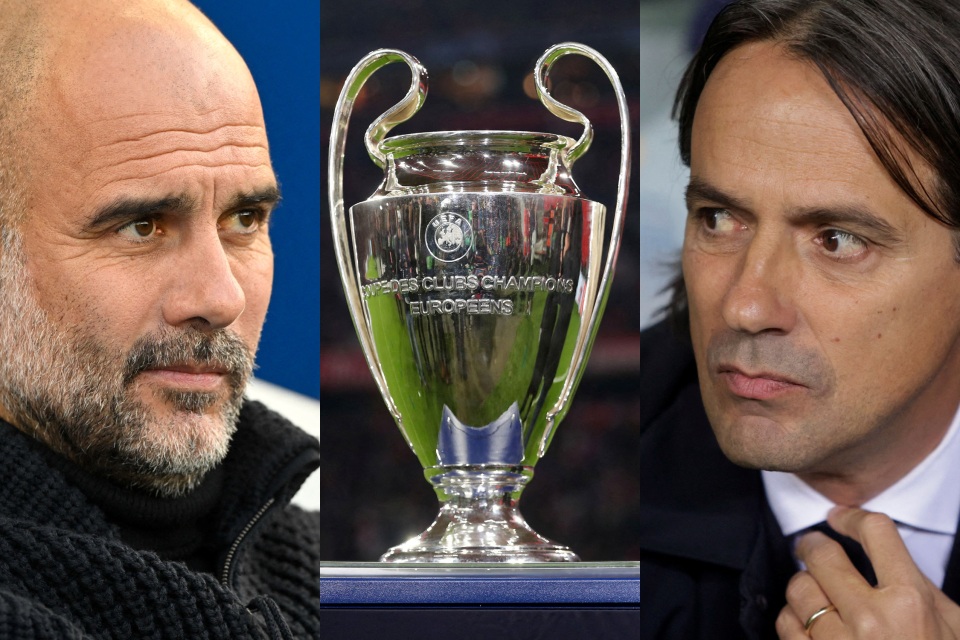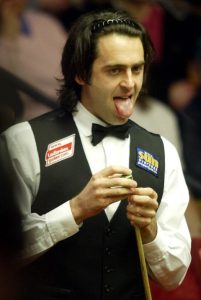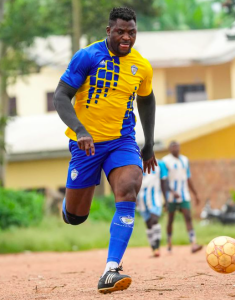Key tactics battles Man City must win to beat Inter Milan in Champions League final and clinch the treble

AFTER ten months of teams battling it out in the Champions League preliminary rounds, the playoffs, the group phase and the knockouts, just two teams remain.
It’s perhaps not a shock to anyone that Premier League champions Manchester City are half of the finalists, having just won a third consecutive league title.
ReutersPep Guardiola and Simone Inzaghi go head-to-head for the Champions League[/caption]
Pep Guardiola’s side are on the cusp of a historic treble and there is just one more obstacle standing in the way of immortality for the Manchester club – Inter Milan.
It was as Barcelona boss on that infamous night in the Nou Camp in 2010 against Jose Mourinho’s side when Guardiola last faced the Nerazzurri.
The Italian giants stopped him from creating history 13 years ago.
Can they do it again, while potentially lifting European club football’s greatest honour for the fourth time ever?
We have decided to take a look at three key tactical areas where this game will be won and lost between Man City and Inter.
Inter’s high press
Arguably the biggest decision Simone Inzaghi will need to make this weekend is whether or not he wants his team to press Man City high up the pitch.
The English champions always want to play out from the back to entice the opposition to commit bodies in the press.
This way, there are fewer protecting the goal.
BETTING SPECIAL – BEST SPORTS BETTING APPS IN THE UK
Pep wants to attract opposition teams into City’s third before carving them open and exploiting the exposed backline.
Some teams are brave, going toe-to-toe with the domestic double-winners when City are building out from the goalkeeper but these are normally high-class opponents such as Manchester United, Arsenal or Liverpool.
For the most part, lesser opponents will drop off into a deeper block, allowing City to play out from the back unscathed.
Haaland has been unstoppable in Europe this season
Former City star Dzeko is Inter’s top scorer in the competition
Given the sheer quality of Man City’s build-up, it will be interesting to see whether Inzaghi decides to press high in Inter’s typical 3-5-2 shape or drop back into a compact 5-3-2 block lower down the pitch.
Should the Nerazzurri engage in the final third, they will deploy a man-marking scheme as the 3-5-2 matches up quite well against the 4-3-3 in this phase.
Given there are three men each in the middle of the park, this will allow Inter to defend man-for-man against what will likely be a trio of Rodri, Kevin De Bruyne and İlkay Gündoğan.
Furthermore, the wingbacks will be instructed to push high and press City’s fullbacks while the centre-forwards press the two centre-backs and the goalkeeper.
Inter are pressing high against Napoli’s 4-3-3 and will face a similar structure in this phase this weekend. The 3-5-2 matches up perfectly against the 4-3-3 when defending man-for-man.
The reward for pressing City in this area of the pitch is that the defending side can win the ball back in a dangerous area and start a counterattack close to the goal, in theory.
However, in reality, this is easier said than done. No matter how intense the opposition press is, City normally find a way to get the ball to their attacking players further up the pitch.
The signing of Erling Haaland gave Guardiola’s men the option to play over the press rather than through it.
The Norwegian goal machine excels in the air and can bully even the toughest defenders.
The worry for Inter will be committing too many bodies in the press and leaving fewer at the back to deal with the long balls from Ederson to Haaland. Arsenal know all about this.
Arsenal were pressing high against City’s build-up attempt. Ederson simply lofted the ball over the press to Haaland who trapped the ball and slipped in De Bruyne for the opening goal.
Rodri was a dominant force in the semi final
It is perhaps a wiser idea for Inzaghi to instruct his players to drop off into a narrow defensive block, not engaging higher up the pitch where they can be carved open with ease.
City can’t concede first
The semi-finals of the Champions League drew up a mouth-watering Derby della Madonnina between Inter and city rivals AC Milan.
It was the first time since 2005 that the duo had faced one another in the UCL knockout phase. However, within eleven minutes, the tie was dead and buried.
Edin Dzeko’s eighth-minute opener was followed by a goal from Henrikh Mkhitaryan in the eleventh minute to ultimately seal the victory for the three-time winners of the tournament.
But it was not Inter scoring twice in the first leg that killed the game, it was because the goals came so early, allowing Inzaghi to change his approach with almost 170 minutes left in the tie.
Inter caught Milan on the break after Federico Dimarco found the Armenian magician with a beautiful cut-back pass to the edge of the area. Mkhitaryan slotted home to seal the win.
This goal prompted a prominent change to the Nerazzurri’s approach in the game.
They no longer needed to pile bodies forward to score and so did the very opposite.
Instead of instructing the wingbacks to advance forward in and out of possession, the head coach ensured that his team dropped off into a compact defensive shape.
There was no longer a need to take risks and so Inter didn’t.
Internazionale’s possession statistics dropped drastically too. In the first fifteen minutes of the game, Inzaghi’s men averaged 56 percent of the ball.
In the 15 minutes following this, that number fell to 29 percent.
In fact, for the rest of the game, Inter’s possession percentage never climbed above 48 percent.
This continued throughout the second leg as Inter registered 42 percent of the ball against Milan in the ‘home’ fixture.
The Italian giants dropped off into a 5-3-2 low block to protect the goal for as long as possible.
Inter worked tirelessly to protect their own third, denying Milan any clear-cut goalscoring opportunities with this condensed 5-3-2 defensive shape.
Inzaghi’s strategy worked. Milan created an xG of just 1.2 in total across both legs as Inter held onto a clean sheet for the entirety of the tie.
It was a defensive masterclass from Inter and a virtuosic tactical performance from the 47-year-old manager.
The Italian side are incredibly difficult to break down when they drop off into a low defensive block.
Manchester City will want to avoid conceding an early goal so to not suffer the same fate as AC Milan.
Stopping City’s wide attacks
Man City’s 4-0 thrashing of Real Madrid in the semi-final second leg last month was arguably one of the most dominant Champions League performances of all-time given the context of Los Blancos being European champions.
From minute one to the referee’s final whistle, the Mancunian side asserted sheer dominance on the field.
Gundogan is likely to be a key figure again
If the game was a boxing match, it would have been stopped after the first round.
The defending champions hardly laid a glove on Guardiola’s hungry pack of wolves.
One of the biggest mistakes Carlo Ancelotti made was deploying a front three with little to no defensive responsibilities.
Karim Benzema, Vinicius Jr and Rodrygo stayed higher up the pitch while the midfield trio and the back four tried to stop the waves of Man City attacks.
Real Madrid were constantly forced to defend 1v1 on the flanks due to the lack of support from the wingers. Eduardo Camavinga in particular had a torrid time versus Bernardo Silva on the right.
Defending with a block of seven against one of the most potent attacking sides in Europe seems like a grave error and in hindsight, it was.
Nevertheless, Inter’s defensive structure will be far better suited to dealing with the wide triangles of City’s wingers, central midfielders and fullbacks than Real Madrid were.
Given that the Nerazzurri defend in a 5-3-2 low block, they will have an extra man already and can potentially have a 4v3 overload against this triangle using the nearest wingback, wide centre-back, central midfielder and pivot player.
Even one of Inter’s two centre-forwards can drop back to cover certain central passing lanes too if necessary.
Inter had a 4v3 overload against Barcelona’s wide triangle, forcing the Spaniards to play backwards and away from danger. Inter won the Group C match 1-0.
It will require a lot of hard work but the Serie A giants can stop these wide attacks from the English champions with cooperation, communication and tactical intelligence.
Arguably the most important attacking arsenal that Inter will need to watch out for is channel runs from the central midfielders.
Gündoğan in particular is excellent at making these little moves between the fullback and the centre-back to receive a through ball in behind, setting him up for a cut-back cross.
Gündoğan latched onto the through ball after making his notorious halfspace run before eventually crossing to Raheem Sterling in the box who poked home to score v Club Brugge last season.
Whether it be the wingbacks, centre-backs or midfielders, someone needs to constantly follow these runs or they will prove to be deadly, especially with an innate predator like Erling Haaland lurking in the penalty area.
What does this all mean?
A failure to collect the trophy in Istanbul and pick up a historic treble would be a catastrophe of seismic proportions.
Man City are heavy favourites to beat Internazionale.
In fact, this is arguably the most one-sided final on paper since Liverpool’s triumph over AC Milan in 2005.
But Simone Inzaghi and his players can learn a few things from that final 18 years ago.
No matter their quality, only 11 Man City players can play, the game isn’t over until it’s over and anything can happen in a final.






